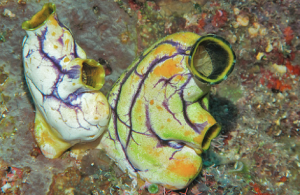The ejection of internal organs, i.e., evisceration, is a well-known phenomenon in sea-cucumbers. We report the ability of a member of the Chordate phyla, the tropical ascidian Polycarpa mytiligera, to eviscerate and regenerate its gut within 12 days, and to rebuild its branchial sac within 19 days. Evisceration occurred within 4–43 seconds of gentle mechanical pressure exerted on the tunic in 47% of the tested P. mytiligera. Individuals were able to discard up to 3/4 of their digestive tract via the incurrent siphon by rupture of the branchial sac in this area.

(a) Evisceration in the field, arrow pointing to the gut expelled through the oral siphon (OS). CS- cloacal siphon. Scale bar 1 cm. (b) Eviscerated gut, including the stomach (St), intestine (Int), endocarp (Ec, a projection of the body wall into the atrial cavity), and part of the rectum (Re). Scale bar 1 mm. Photo: G. Koplovitz, T. Gordon.
Although chemical analysis revealed no significant levels of toxic compounds, the eviscerated guts were unpalatable to the triggerfish and pufferfish on which they were tested, suggesting evisceration as a defense mechanism. Given the close affinity of ascidians to vertebrates, the regeneration pathway of the viscera and branchial sac of ascidians suggests its potential beneficial application in soft tissue regeneration research.



















